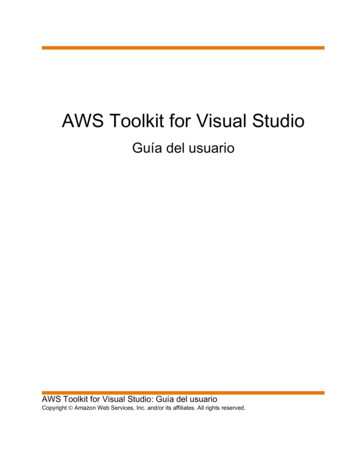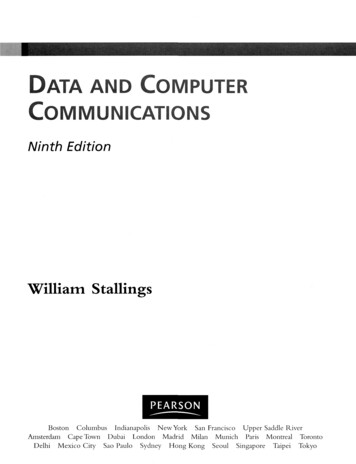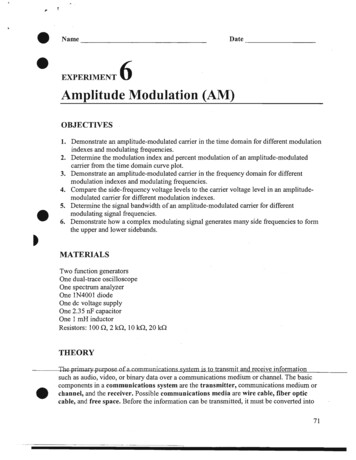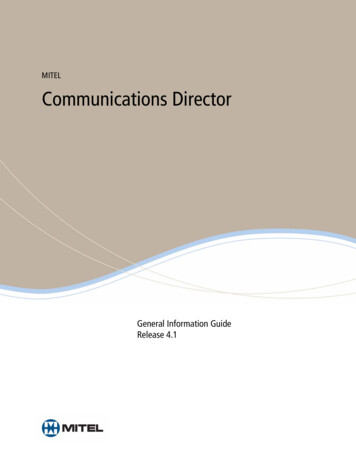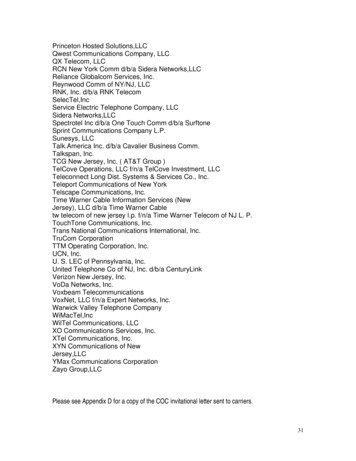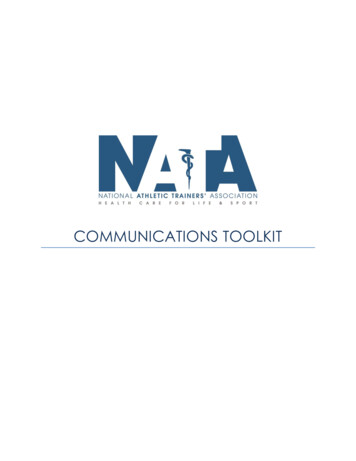
Transcription
COMMUNICATIONS TOOLKIT
The NATA Communications Toolkit is designed to help NATA districts distributeinformation to their membership. Keep reading to find the following:oSample Communications Strategic Plano Creating a plan is the first step toward success. This sample shows the traditionalcomponents of a communications plan, which helps provide focus and structurefor an organization’s communication strategy.oTemplate: Annual Communications Calendaro Organize your communications with this calendar, which provides a broadoverview of scheduled events, promotions and campaigns.oTemplate: Monthly Communications Run Sheeto For those who have multiple people on the communications team, a run sheet isdesigned to provide the month’s strategic focus and keep everyone on the samepage. It should be distributed at the beginning of the month to help organize thatmonth’s strategies and tactics.oSocial Media Best Practiceso Want to expand or improve your social media presence? This document providestips and tricks for social media managers.oMeasuring Social Media Effortso Wondering how to measure if your social media tactics are working? Thisdocument provides an overview of Twitter and Facebook analytics.oNATA News District News Submission Calendaro Get your district information included in the NATA News by following the guidelinesand deadlines on this calendar.oNATA Verbal Style Guideo Athletic training has its own terminology, and NATA follows specific rules within itspublications. Districts are encouraged to adopt these guidelines to help convey aconsistent message to the general public.oLogo Guide for Districts & Stateso Interested in a district or state logo incorporating NATA’s “AT” symbol? We’llexplain the logo design process within this guide.To download these documents and templates, visit ources.If you have further questions, contact NATA Communications Manager Beth Sitzler atbeths@nata.org.
[Sample] Communications Strategic Plan[SAMPLE] COMMUNICATIONS MISSIONDevelop and utilize all communication vehicles to advance initiatives; collaborate withother departments/volunteers to communicate relevant news to membership; driveconversation and member engagement to increase the value of members.Note: A communications strategic plan should be designed to execute a district’s strategic plan.Communications goals should be aligned with district goals. If you need assistance with yourstrategic plan, contact NATA Communications Manager Beth Sitzler (beths@nata.org).Marketing/communications plans usually contain the following information for each goal:GoalooooooMetrics (how you will measure the success of the goal – can be statistics or taskdeadlines)Strategies (how you plan to accomplish the goal)o Tactics (specific plans/techniques to achieve the strategy)o Include launch dates for each strategy and tactic so progress can be measuredProgress Checkpoints (designated times to assess progress toward the goal)Reporting (statistics and other measurements to gauge progress toward the goal)Target (target audience for the particular goal)Budget Implications (costs involved with proposed strategies and tactics)The next page shows an example goal and how the metrics, strategies, tactics, etc., factor intothe success of that particular goal.
[Sample] Communications Goal: Utilize communication channels to increase professional pridewithin the membership, emphasizing resources to help ATs advocate on behalf ofthe profession. Grow overall reach of and audience for communication vehicles to increaseawareness and influence of athletic training profession.[SAMPLE] METRICSoIncrease overall web traffic by % (Baseline: monthly visits in 2020)oConduct membership experience survey by Aug. 15[SAMPLE] STRATEGIESoReorganize the website with a focus on improved navigation to improve member experience.Launch date: FebruaryoUtilize social media channels to foster a sense of community and engagement among themembership. Utilize contests (2-3/year), hashtags (6-10/year) and live-Tweeting (5-6 events/year) to encourage participation. Cross-promote LinkedIn conversations on other channels toencourage more dialogue. Launch date: OngoingoPromote the online newsletter and blog in targeted e-blasts to increase online engagementand visitors to the website. Launch date: May - December[SAMPLE] TACTICSoConduct interactive social media campaigns around the following key initiatives: NATM,membership renewal, annual meeting and advocacy activities. All events will be liveTweeted with a specific hashtag to encourage awareness and member interaction. Launchdates: March, June, October[SAMPLE] PROGRESS CHECKPOINTSoCheckpoints every two weeks for website reorganization project, coinciding with the vendor’stwo-week sprintsoMonthly checkpoints for newsletter and blogoMonthly digital communication reports[SAMPLE] REPORTINGoMember experience survey resultsoMonthly reports on social media, eblasts, website analytics[SAMPLE] TARGEToMembers[SAMPLE] BUDGET IMPLICATIONSoCost for vendor to reorganize website: oConsider investing in more sophisticated social metrics
COMMUNICATIONS CALENDAR: Use this as an internal guide to keep track of eachmonth’s activities and events that align with your communications strategic plan. It should behelpful to see which months are too busy to initiate new activities and which months havecomplementary topics/points of emphasis.JANUARYFEBRUARYMARCHNational Athletic RNOVEMBERDECEMBER
[SAMPLE] COMM TEAM RUN SHEET: MARCHPublication/Newsletters-March: NATA convention education previewWorking on: April – The Education IssuePrepping for: May – Hall of Fame/AwardsBlog/Social/eblasts--National Athletic Training Montho Update profile pics on social media channels to NATMlogoNATA convention registration opens in MarchNATM Poster ContestNATM Public Relations ContestWebsites-Promote NATM resourcesContinue homepage re-organizationNATA convention registration launches in MarchCurrent Marketing Campaigns:-NATA conventionMembership recruitmentUpcoming Events-Capitol Hill Day Washington, D.C.NATA 2020 (June 17-20) AtlantaAdditional Points of Emphasis:-NATA convention speaker videosEncourage online readership of blog/magazine/newsletterEncourage NATM participation
NATA Social Media Best PracticesSocial media platforms (i.e. LinkedIn, Instagram, Facebook, etc.) have the potential to increaseyour public profile. Through them you can create grassroots campaigns, engage with yourtarget audience and industry influencers and build expert and brand awareness. If you createand share worthwhile content, you can also position your social site as a resource for influencers,AT enthusiasts and ultimately increase your followers/fans. 2*If you have additional questions about setting up or monitoring your social media accounts, contact ToddChristman (toddc@nata.org), who oversees NATA’s social media efforts.Setting up your social accountsIf you want to set up a social media account that is affiliated with NATA or a specific district,contact Todd Christman (toddc@nata.org) so he can set it up for you.How-to guides for beginnersIf you’re a complete novice to the social media world, here are a few helpful resources that candirect you. They all are broken down by social network, so you can easily find the specificinformation you need.1. https://moz.com/beginners-guide-to-social-media2. ckstarter/3. ge size guideFacebookProfile picture: 180 180 pixelsCover photo: 851 315 pixelsTwitterProfile photo: 400 400 pixelsHeader image: 1,500 500 pixelsImage details for other social media channels can be found ent Management TipsManagement systems such as Hootsuite (https://hootsuite.com) and Tweetdeck(https://web.tweetdeck.com)make it much easier to view not only your own content butcontent posted by others that involves or is about you. Features of these systems includescheduling posts, setting up a dashboard where you can easily see other timelines you create toview searches, mentions, favorites and hashtag tracking.Measurement & Analytics
There are a variety of ways to delve into the statistics of your social accounts. Twitter andFacebook offer their own analytics services (https://analytics.twitter.com andwww.facebook.com/insights). You can also employ outside services, some of which are free (oroffer free options), or explore other options that are offered at a variety of price points. A freeand easy place to start is http://twittercounter.com, which tracks your number of followers overtime.Social Media Best Practices1. Determine the strategic areas of focus for your state/district/target group.This discussion and/or work should happen prior to engaging socially. Your social mediaplan should support overall strategic goals.2. Establish a social media community team.Your community team is comprised of people who are most actively listening andengaging on behalf of the brand/group and through the group page. These are theindividuals who will develop content, listen and engage in conversation on behalf ofyour group. This does not mean other members of the group/organization are notactively involved in the conversations. Ideally, your entire group/organization is social.However, your community team will be the facilitators, deliberately listening andengaging on behalf of your group/organization.3. Identify roles, responsibilities and expectations.Content Creator and Distributor: Develops the editorial content calendar, schedulesdelivery and posts on social site(s).Listener: Social listening is simply monitoring social scenes for relevant topics/brandmentions. Being an active listener means that you can alert appropriate parties whennecessary to any issues as they occur.Engager: Appropriately engaging with and responding to social fans/followers.4. Establish your voice/tone for your social communication.NATA has adopted a professional but conversational and transparent approach tosocial media engagement. Openness goes a long way in social media. It’s a big part ofbuilding trust with your social community.Also, if your goal is to be a resource, consider that when engaging with followers/fans. Inaddition to content, what can you provide that will enhance their experience with yousocially (i.e., resource sharing, video from a district leader, etc.).5. Determine and educate yourself on what to respond to and what not to respond to.As a part of the listening process, you must determine the types of comments/posts youwill and will not respond to.NOTE: When posting content on behalf of the AT profession and/or NATA, different rulesapply. If the conversation is peer-to-peer and no question has been posed to you (or
your page), should you jump in? The general rule of thumb is no. Let the conversationgrow organically. If, however, there is a question about NATA, formalpositions/statements, resources or the like that warrants your engagement, feel free torespond. However, please keep your response objective and short. If you are not surehow to respond to a post or would like someone to review your response, contact thenational communications team before responding.The following are a few good opportunities for engagement: Mentions of NATA, your district or your committee’s participation in industry events orpresentations Compliments Customer service/support issues or inquiriesAs a rule-of-thumb, respond to the good and bad, but not the ugly. Though it may betempting to respond to positive feedback and delete the negative, don’t. If youreceive negative feedback, take it as constructive criticism and an opportunity toimprove. If someone is complaining, they’re more than likely looking for a resolution.Very rarely do people merely want to complain. Therefore, respond as quickly aspossible and avoid the urge to purge.2 Questions/inquiries about processes, policies, recommendations, etc. that provideyou with an opportunity to educate or direct the fan/follower to support resources Membership inquiries Membership benefit inquiriesWhen is responding not advised?Consider the saying “don’t feed the trolls.” Knowing when to take the high road andwhen not to engage is as important as knowing when you should respond. On occasionthere will be people who want to engage in a public debate and perhaps embarrassthe brand. If you respond to these types of posts, you will be feeding that need. Mostpeople see through the effort of these people and they don’t expect you to feed thetrolls – so don’t. Instead, please forward this information to NATA’s Todd Christman attoddc@nata.org.The following are some examples of posts that you may choose to avoid responding to: Generic mentions among a sea of other associations or health care professionals,without commentary that’s positive or negative Sarcastic, snarky or potentially inflammatory comments Straight retweets of company content or company news without any additionalcommentary Peer-to-peer conversations that mention your company in passing, in which yourinvolvement could be perceived as intrusive Posts that require national office intervention, negative post or misinformation youneed to correct (Please forward this posts to the national communications team.) Rumors, law suits, negative media attention/press for NATA or any company,organization and/or third party entity (Please forward this information to the nationalcommunications team.)
Information that you want to avoid sharing includes: Any NATA national news that has not been formally communicated by the nationaloffice Job postings. All AT job postings are to be listed in the Career Center only Political announcements/endorsements Corporate and/or product mentions, including messages from sponsors Public apologies or explanations of action Profanity or inappropriate subject matterBEST RULE OF THUMB: WHEN IN DOUBT, DON’T POST.Social Media Live Steaming Tips(if you would like to explore live streaming opportunities, contact marketing@nata.org)Start earlyTo allow time for live notifications to be received and for the few seconds that the video maylagPromote ahead of timePreferably two weeks in advance, day before and one hour before live is to start. Ask audienceto share as wellDuration – 30 minutes at minimumThis allows time for viewers to join. If video is longer than 30 minutes repeat topic for new viewersjoiningWi-FiSignal testing – Camera appTimeIs the prime audience available at the desired time?Consider AudienceIs content relevant to all followers? If not, customize a Facebook groupEngage with commentsInteract with viewers. Include them in conversation by answering questions, and addressingthem by name – to increase interactionPreferred Number of SpeakersSmall number of static speakers (preferably 1-2, no more than 4)Visual appealConsider lighting, setting, number of speakers
VolumeBroadcast from a small space, such as an office, to eliminate echo and ambient noise.Viewers - encourage viewers to use earphones if they are viewing on a computer.Equipment needed Camera Camera battery iPad Hotspot Power strip Tripod*Fully charge all items the day before: camera and camera battery**Run tests!!!Why (and How) You Should Use Facebook LiveTo Connect with Your Audience in the Most Genuine, Human Way PossibleTo Answer Questions in Real TimeTo Showcase an Event to People Who Couldn’t Attend In Real LifeTo Share Industry-Related UpdatesTo Show Off Your Company 31/facebook-live-guideFacebook Live TipsIntroduce Yourself RegularlyMake Your Video Visually EngagingKnow Your Target AudienceReinforce Your AuthorityOnly Broadcast When You Have a Strong SignalHave a StructureCheck the CommentsAsk for Follows, Shares, Likes, and NotificationsUse TeasersBuy a Mic and ing-facebook-live/Facebook Live Best PracticesFace a Window!Film Horizontally on Your Mobile DeviceCreate a Few Practice Videos on Your ProGet PersonalSmile, and Be Properly Caffeinated!Embrace Small MistakesAsk Your Viewers to InteractHave Someone Monitor Comments and Feed You Questions
Call Out Your Commenters by NameGive an Actionable Sign-OffUpload a Custom ThumbnailPin Your Post to the Top of Your News FeedAdd Captions to Your VideoIf Your Video was a Real Hit, Make it the Featured VideoPromote Your Video After the FactAnalyze Your /07/31/facebook-live-guideFacebook Live Mistakes to AvoidBe unclear in your heading and descriptionMake it shortUse it as a sales pitchInclude long awkward pausesMake it low-qualityAlienate your audienceDrop out/ start bufferingBroadcast to nobodyFinish the stream and forget about acebook-live-mistakes-to-avoid/543093/More Social Media TipsSocial media K.I.S.S (Keep It Significant and Shareable)The most critical component of social engagement and success is your ability to developcontent that initiates and encourages organic conversation and sharing.Develop an editorial calendar that addresses the various needs of the social fans/followers inyour network. Create content that’s engaging, contextually relevant and shareable. Thinkbeyond the basics and use polls, promotional content and questions to your advantage. 3 Aswith our natural conversation, which is never one dimensional, your editorial calendar shouldinclude a balance of content that is educational, resourceful, entertaining and encouragesengagement and action.Growing Your NetworkWhile large numbers are impressive, the most effective measure of social success isengagement. Therefore, while you want to grow your network, focus on organic (earned)fans/followers based on providing relevant, significant and shareable content. While there areseveral paid options to expedite fan/follower growth, NATA recommends organic and earnedgrowth, which traditionally results in greater engagement. Create editorial content that fans will share. The more they share, the larger your networkgrows. Retweet and share influencer content.
Include relevant handles/usernames in posts. When people see they are mentioned,they are more likely to retweet and favorite, which can help make their followers youraudience.When posting a link, include at least some descriptive text. A link without any contextdoes not lend itself to clicks.Use hashtags. Although most associated with Twitter, Facebook uses them now as well.Hashtags can be used to help spread the word about an event or campaign. They alsoallow for easier categorization and can be used as effective search terms.References & ResourcesHere are a couple of resources from social/digital communication experts that we frequent as aresource of information. We used the following resources to build this best practices document:1. or-long-term-social-media-success/2. practices-for-brand-engagement/Updated 09/03/19
NATA News Production Schedule 2020**Please submit district news to Editor-in-Chief Beth Sitzler at beths@nata.org.ContentDue to NATAAd Reservations DueAd materials due @ NATAFILES & INSERTS DUE @PRINTERJANUARYNov. 19Nov. 25Dec. 4Dec. 16FEBRUARYDec. 12Dec. 19Jan. 3Jan. 15MARCHJan. 23Jan. 29Feb. 5Feb. 17APRILFeb . 25March 2March 9March 19MAYMarch 23March 29April 3April 16JUNEApril 22April 28May 5May 15JULYMay 27June 2June 9June 18AUG/SEPTJuly 22July 27Aug. 4Aug. 17OCTOBERAug. 21Aug. 27Sept. 4Sept. 17NOVEMBERSept. 22Sept. 28Oct. 5Oct. 15DECEMBERSubmission aren’taccepted this editionOct. 28Nov. 4Nov. 16
NATA Verbal Style GuideJanuary 2020Associated Press is the default style of NATA.Athletic trainer or AT– Athletic trainer or AT are the preferred terms. NEVER use trainer or certified trainer. If this occurs ina direct quote, use “[athletic] trainer” or “certified [athletic] trainer.”– Use AT as the abbreviation. Use ATC only when referring to the credential, not to a person.– Do not use ATC/L, ATC/R, LATC or any other combination of ATC, as the credential istrademarked.– We do not use “certified athletic trainers” unless the circumstance requires distinction. We doallow this term within BOC submissions to NATA publications.Athletic training– “Athletic training” and “athletic trainer” are not capitalized unless part of a proper noun.– Avoid using “AT” as an acronym for the term athletic training as a noun. It may be used as anacronym in the adjective form.– Correct: The new AT facility was unveiled.– Incorrect: When studying AT, a student should Athletic training room/athletic training facility– Preferred term is athletic training facility.– Do NOT use training room.– The Uniform Terminology Project group said, “We should refer to our secondary school andcollege-based work spaces as facilities or clinics.”Athletic training students– High school students are referred to as athletic training student aides, NEVER student trainers.– College students are referred to as athletic training students, NEVER student trainers.Athletic training education programsThe new acronym is “ATP.” We no longer use “ATEP.”Athletic training “customer”Per the Uniform Terminology Project group, athletic trainers treat patients or clients. “The committeerecognizes that athletes still comprise a significant proportion of the population who receives ourcare. However, once an athlete (or any other individual who receives our services) becomesinjured, he or she is a patient. Client should be used for situations where individuals receive ourservices – usually preventative in nature – on a fee-for-service basis.”Credentials– Use credentials on first reference. (Check Nimble to confirm certification.)– Follow the BOC's guidelines on listing and abbreviating (degree, license, credential)– Do not use periods within credentials (contrary to AP Style).– Correct: John Doe, PhD, ATC– Use commas after the credential: John Doe, PhD, ATC, works for Mercy Hospital.– Use a maximum of three credentials, with educational degrees listed before professionalcertifications. At least one of the three credentials MUST be ATC (if the person is certified). Thenational credential supersedes the state license.Health care– “Health care” is two words unless part of a formal noun.– Correct: ATs are health care providers.– Correct: United Healthcare is an insurance provider.NATA– Plural possessive: National Athletic Trainers’ Association– When using the abbreviation NATA as a noun, do not precede it with “the.”
– Correct: When NATA was founded – When “NATA” is used as an adjective, it’s proper to use “the.”– Correct: The NATA Governmental Affairs Committee is meeting this weekend.NATA Research & Education FoundationWrite out the full name on first reference and use “NATA Foundation” subsequent references. DoNOT use “the Foundation” or “REF.”DistrictsNATA comprises 10 districts, each incorporated separately. We spell out each district number (evenDistrict Ten, contrary to AP Style) in NATA publications. Refer to them as such:– District One or Eastern Athletic Trainers’ Association or EATA– Connecticut Athletic Trainers’ Association or CATA– Rhode Island Athletic Trainers Association (no apostrophe) or RIATA– Athletic Trainers of Massachusetts or ATOM– Vermont Association of Athletic Trainers or VAAT– New Hampshire Athletic Trainers’ Association or NHATA– Maine Athletic Trainers Association (no apostrophe) or MATA– District Two or Eastern Athletic Trainers’ Association or EATA– Delaware Athletic Trainers Association or DATA– Athletic Trainers’ Society of New Jersey or ATSNJ– New York State Athletic Trainers’ Association or NYSATA– Pennsylvania Athletic Trainers’ Society or PATS– District Three or Mid-Atlantic Athletic Trainers’ Association. Avoid MAATA becauseDistrict Five is also MAATA.– Maryland Athletic Trainers’ Association or MATA– North Carolina Athletic Trainers’ Association or NCATA– South Carolina Athletic Trainers’ Association or SCATA– Virginia Athletic Trainers’ Association or VATA– West Virginia Athletic Trainers’ Association or WVATA– Also the District of Columbia– District Four or Great Lakes Athletic Trainers’ Association or GLATA– Indiana Athletic Trainers’ Association or IATA– Illinois Athletic Trainers Association (no apostrophe) or IATA– Michigan Athletic Trainers Society (no apostrophe) or MATS– Minnesota Athletic Trainers’ Association or MATA– Ohio Athletic Trainers’ Association or OATA– Wisconsin Athletic Trainers’ Association or WATA(GLATA also includes Manitoba and Ontario in Canada)– District Five or Mid-America Athletic Trainers’ Association. Avoid MAATA because District Three isalso MAATA.– Iowa Athletic Trainers’ Society or IATS– Kansas Athletic Trainers Society (no apostrophe) or KATS– Missouri Athletic Trainers’ Association or MOATA– Nebraska State Athletic Trainers’ Association or NSATA– North Dakota Athletic Trainers’ Association or NDATA– Oklahoma Athletic Trainers’ Association or OATA– South Dakota Athletic Trainers’ Association or SDATA– District Six or Southwest Athletic Trainers’ Association or SWATA– Arkansas Athletic Trainers’ Association or AATA– Texas State Athletic Trainers’ Association or TSATA
– District Seven or Rocky Mountain Athletic Trainers’ Association or RMATA– Arizona Athletic Trainers’ Association or AzATA– Colorado Athletic Trainers’ Association or CATA– New Mexico Athletic Trainers’ Association or NMATA– Utah Athletic Trainers’ Association or UATA– Wyoming Athletic Trainers’ Association or WYOATA– District Eight or Far West Athletic Trainers’ Association or FWATA– California Athletic Trainers’ Association– Nevada Athletic Trainers Association (no apostrophe) or NEV-ATA– Hawaii Athletic Trainers’ Association or HATA– District Nine or Southeast Athletic Trainers’ Association or SEATA– Alabama Athletic Trainers’ Association or ALATA– Athletic Trainers’ Association of Florida or ATAF– Georgia Athletic Trainers’ Association or GATA– Kentucky Athletic Trainers’ Society or KATS– Mississippi Athletic Trainers’ Association or MATA– Louisiana Athletic Trainers’ Association or LATA– Tennessee Athletic Trainers’ Society or TATS– District Ten or Northwest Athletic Trainers’ Association or NWATA– Alaska Athletic Trainers’ Association or AATA– Idaho Athletic Trainers’ Association or IATA– Oregon Athletic Trainers’ Society or OATS– Montana Athletic Trainers’ Association or MATA– Washington State Athletic Trainers’ Association or WSATA(NWATA also includes Alberta, British Columbia and Saskatchewan)NATA CommitteesWhen referring to NATA committees, always include NATA in front of the committee name on firstreference (i.e., NATA Young Professionals’ Committee). On second reference, use the acronymwithout NATA (i.e., YPC).NumbersUse numerals in relation to the amount of continuing education credit received. In all othercircumstances, follow AP Style.– Remember to use “more than” when referencing a numerical amount, not “over.”– Correct: More than 20 people attended.– Incorrect: Over 20 people attended.Orthopedic/OrthopaedicPer AP Style, use the American spelling (orthopedic, orthopedics). Use the British spelling(orthopaedic) only as part of a proper noun.– Correct: The American Academy of Orthopaedic Surgeons has issued a new positionstatement on orthopedic injuries.WebsiteProper usage is “website,” rather than the previous AP Style of “Web site.” Also, use webcam,webcast and webmaster. But as a short form and in terms with separate words, the Web, Webpage and Web feed.Evidence-Based Practice CEUsWrite out the full term, all words capitalized, in the first reference and use “EBP” for subsequentreferences.
Continuing education and CEUs– When describing a numerical amount of units earned or available, the proper acronym is CEU.– Correct: Up to 14 CEUs available– When describing the general term of “continuing education,” CE is an acceptable acronym.– When obtaining CEU credit, the person receives a “Statement of Credit” instead of the formerterm, “certificate.”Convention Terminology– The proper name in 2020 is 71st NATA Clinical Symposia & AT Expo. On second reference, it’s“convention” or “NATA convention” or “NATA 2020.”– The correct names and treatment of various functions at the convention are:– Athletic Training Student Seminar, or ATSS– ATSS Ron Culp NBATA Cadaver Workshop, or cadaver workshop– AT Expo– National Quiz Bowl, or quiz bowl, or student quiz bowl, which awards the Eve BeckerDoyle Quiz Bowl Championship Cup– Pinky Newell Scholarship & Leadership BreakfastStudent AthletesWe refer to “student athletes,” without a hyphen.NonmembersThe proper term is “nonmember,” without a hyphen.Return-to-play vs. return to playReturn to play is hyphenated when part of a compound modifier.– Correct: The AT is in charge of making return-to-play decisions.Do not hyphenate when saying “John will return to play tomorrow.”Doctor vs. physicianUse the term “physician” instead of “doctor” to avoid confusion, since “doctor” can designate aPhD as well.Addresses– Use the abbreviations “Ave., Blvd., and St.” only with a number address; spell out and capitalizewhen part of formal street name without a number– Correct: He lives at 555 Washington St. She lives off Walnut Avenue– Even with a number address, all similar words (lane, road, court, parkway, etc.) are alwaysspelled out– Correct: She lives at 555 Jefferson Parkway, while he lives at 555 Washington St.– When using a full address, with state and zip code, use the two-letter postal code abbreviation– Correct: John Doe, 1620 Valwood Parkway, Carrollton, TX 75006– When using a city and state, always write out the state– Correct: Carr
o Social Media Best Practices o Want to expand or improve your social media presence? This document provides tips and tricks for social media managers. o Measuring Social Media Efforts o Wondering how to measure if your social media tactics are working? This documen



